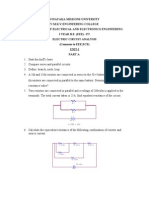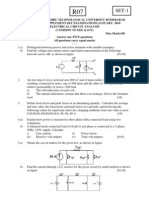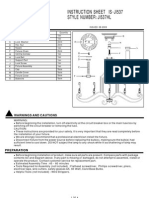Assignment CT
Uploaded by
dhinojahimeshAssignment CT
Uploaded by
dhinojahimeshNIRMA UNIVERSITY
INSTITUTE OF TECHNOLOGY B.Tech. SEM -IV SUBJECT- 2EE225 CIRCUIT THEORY TERM ASSIGNMENT:- 1
1.
Find the total current in the circuit.
2.
Find the value for the unknown voltage source.
3.
Determine the current I and its direction.
4.
Use the Voltage Divider Rule to find the voltage VAB
5.
Find R1.
6.
Determine the voltage VAD.
7.
Using the circuit of previous problem find the voltage VCB.
8.
Find the current I6.
9.
Find the resistance R2 in the diagram for previous problem.
10. Find the internal resistance of a battery that has a no-load output voltage of 100V and that supplies a current of 2 A to a load of 40 ohms. 11. Find the power loss in the battery of previous problem. 12. Define the following terms (i) Branch (ii) Node (iii) Planner graph (iv) Controlled source
TERM ASSIGNMENT:- 2 1. Determine the current through the 4 resistor branch of the given network using mesh analysis.
2.
Find out the values of currents i1, i2 and i3 using mesh analysis. 3.
Use nodal equations to determine ix for the network shown in the figure.
4.
Determine the current through the branch AB of the given network using nodal analysis.
5.
Draw the exact dual of the network shown in the figure.
6.
Determine the current in 1 resistor using source transformation method.
Assignment: 3
Network Theorem
1. If Rg in the circuit shown in the given figure is variable between 20 ohm and 80 ohm, then the maximum power transferred to the load RL will be
(a) 15 W (b) 13.33W
(c) 6.67W
(d) 2.4W
2. Which one of the following theorems is a manifestation of the law of conservation of energy? (a) Tellegens theorem (c) Thevenins theorem (b) Reciprocity theorm (d) Nortons theorem.
3. In an ac network, the Thevenins impedance and Nortons impedance as seen from any two terminals are (a) always same (c) generally the same (b) sometimes same (d) mostly same
4. Determine the current in I through 100 V source in the network shown in fig., using super position theorem.
[Ans : -0.75A]
5. Determine the maximum amount of power that could be dissipated in RL in the network shown in fig. Also find RL.
[Ans : RL= 15.8 ohm, Pmax = 6.33W] 6. Calculate the VTH and RTH across AB in the network using Thevenin Theorem.
[Ans : VTH = 4.4751 V, RTH = 9.585 V] 7. Determine current in 1 ohm resistance using Norton`s Theorem.
[Ans : 0.406 Amp]
8. The network contains a single current source I = 12 90o A. Determine the voltage V2 at node 2 using the reciprocity theorem.
[Ans : V = 7.45 99.64 volt]
Assignment : 4 Initial Conditions 1. In the network of fig, a steady state is reached with switch k closed. At t =0, the switch is opened. Determine i and di/dt at t = 0 +.
[Ans : V/R2 , -R1V / R2L ] 2. In the network of fig, a steady state is reached with the switch k open. At t=0, switch is closed. Determine the values of i1, i2 and i3 at t = 0 + .
[Ans : 1 A, 0.333 A, 0 A]
3. In the given network , the switch k is closed at t=0 connecting an unenergized system to a voltage source. Determine the values of i1, i2, di1/dt and di2/dt at
t = 0 +.
[Ans : 1 A, 0 A, -49.990 A/s, 10 A/s] 4. In circuit shown below, the switch is moved from position 1 to 2 at t = 0. Determine d2i/dt2 (0+). Also find dv 1 /dt (0+) and dv2 /dt(0+), assuming v1(0+) = 10 V and v2(0+) = 0 V.
[Ans : 103 Amp/sec2, 1 volt/sec, -107 volt/sec ] 5. In the circuit, the 4 resistor is shorted out at t = 0. Find the voltage Vc across capacitor C and current i2 through inductor L at t = 0- .Find the values of i1, i2, di1 /dt and di2 /dt at t = 0+.
[Ans : 2.4 A, 3 A, - 0.48A/s , 3 A/s]
You might also like
- BE3251-BASIC ELECTRICAL AND ELECTRONICS ENGINEERING-985171954-BE 3251 BEEE NotesNo ratings yetBE3251-BASIC ELECTRICAL AND ELECTRONICS ENGINEERING-985171954-BE 3251 BEEE Notes64 pages
- Basic_Electrical,_Electronics_and_instrumentation_Question[1]No ratings yetBasic_Electrical,_Electronics_and_instrumentation_Question[1]93 pages
- Question Bank With Answers: BE 8253 - Basic Electrical, Electronics and Instrumentation EngineeringNo ratings yetQuestion Bank With Answers: BE 8253 - Basic Electrical, Electronics and Instrumentation Engineering93 pages
- PHY301 - Previous Assignments SolutionsNo ratings yetPHY301 - Previous Assignments Solutions22 pages
- WWW - Manaresults.Co - In: Electrical Circuits Analysis-INo ratings yetWWW - Manaresults.Co - In: Electrical Circuits Analysis-I9 pages
- Section-A: Question Carries One Mark. The Symbols and Denoted Letters Have Their Usual Meanings 30 X 1 30No ratings yetSection-A: Question Carries One Mark. The Symbols and Denoted Letters Have Their Usual Meanings 30 X 1 3016 pages
- Anna University Examination Questions: EE6201-Circuit Theory NOV - 2015No ratings yetAnna University Examination Questions: EE6201-Circuit Theory NOV - 20159 pages
- Common Course BrainStorming Questions FinallNo ratings yetCommon Course BrainStorming Questions Finall107 pages
- Electrical Circuits Analysis-I Question Paper67% (3)Electrical Circuits Analysis-I Question Paper9 pages
- Circuit Theory - Solved Assignments - Spring 2009No ratings yetCircuit Theory - Solved Assignments - Spring 200933 pages
- BE3251 BEEE QB 02- By www.LearnEngineering.inNo ratings yetBE3251 BEEE QB 02- By www.LearnEngineering.in93 pages
- 205 Exam1 - Fall22 - 23 - Ideal Solution - Students - VersionNo ratings yet205 Exam1 - Fall22 - 23 - Ideal Solution - Students - Version5 pages
- Circuit Analysis - I Year ECE - Question Bank100% (2)Circuit Analysis - I Year ECE - Question Bank20 pages
- EC2011-Network Theory Monsoon Semester-2015No ratings yetEC2011-Network Theory Monsoon Semester-20152 pages
- Eee 2019 Test II (Solutions) 2020-2021 Academic YearNo ratings yetEee 2019 Test II (Solutions) 2020-2021 Academic Year9 pages
- Basic Electrical and Electronics - Question Bank With AnswerNo ratings yetBasic Electrical and Electronics - Question Bank With Answer93 pages
- 13c.Twenty objective bits with answer per unitNo ratings yet13c.Twenty objective bits with answer per unit21 pages
- Design of Electrical Circuits using Engineering Software ToolsFrom EverandDesign of Electrical Circuits using Engineering Software ToolsNo ratings yet
- Electromagnetic Compatibility (EMC) Design and Test Case AnalysisFrom EverandElectromagnetic Compatibility (EMC) Design and Test Case AnalysisNo ratings yet
- LIC's Jeevan Arogya Final Version Dated 08.11.2019 1No ratings yetLIC's Jeevan Arogya Final Version Dated 08.11.2019 118 pages
- Wonderware Manufacturing Solutions: Mike LlapitanNo ratings yetWonderware Manufacturing Solutions: Mike Llapitan21 pages
- DRAFT Landscape of COVID-19 Candidate Vaccines - 19 October 2020No ratings yetDRAFT Landscape of COVID-19 Candidate Vaccines - 19 October 202011 pages
- Institute of Technology B.Tech. Sem-IV (Instrumentation & Control) Circuit Theory (2EE225) List of Self Learning MaterialNo ratings yetInstitute of Technology B.Tech. Sem-IV (Instrumentation & Control) Circuit Theory (2EE225) List of Self Learning Material1 page
- The Importance of Being Earnest (05-06) Resource GuideNo ratings yetThe Importance of Being Earnest (05-06) Resource Guide26 pages
- 2012 U8T8R 4G#430 ADL024 0028 - eATP - Atp - ChecklistNo ratings yet2012 U8T8R 4G#430 ADL024 0028 - eATP - Atp - Checklist42 pages
- Features Description: Toy Motor Driver Series MX214No ratings yetFeatures Description: Toy Motor Driver Series MX2148 pages
- Isp - 07Nt: Automatic Controller of Cutting Thickness For Conveyor Cutting MachinesNo ratings yetIsp - 07Nt: Automatic Controller of Cutting Thickness For Conveyor Cutting Machines13 pages
- Instruction Sheet Is Ji537 - Style Number Ji537Hl:: Package ContentsNo ratings yetInstruction Sheet Is Ji537 - Style Number Ji537Hl:: Package Contents4 pages
- 20 Most Repeated Topics in JAMB Physics Exam 2025 - StudentshipNo ratings yet20 Most Repeated Topics in JAMB Physics Exam 2025 - Studentship38 pages
- Design & Analysis of High Speed Low and Area CMOS Based Comparator With Different ArchitecturesNo ratings yetDesign & Analysis of High Speed Low and Area CMOS Based Comparator With Different Architectures4 pages
- GW - Lynx Home S Series (HV) - Datasheet-ENNo ratings yetGW - Lynx Home S Series (HV) - Datasheet-EN2 pages
- Afullydepletedlean channeltransistorDELTA anovelverticalultrathinSOIMOSFETNo ratings yetAfullydepletedlean channeltransistorDELTA anovelverticalultrathinSOIMOSFET5 pages
- Lenscrafters #5645 (Electrical Estimate) - Counts Gear 5.9.2023 at 5.58AMNo ratings yetLenscrafters #5645 (Electrical Estimate) - Counts Gear 5.9.2023 at 5.58AM1 page
- Oil Less Air Compressor Dental Suction UnitNo ratings yetOil Less Air Compressor Dental Suction Unit6 pages
- Eee52 - Electrical Machines - Ii - Fast Track 2019100% (2)Eee52 - Electrical Machines - Ii - Fast Track 20194 pages
- Ang Kalagayan Ni Juan: Paano Po Mag-Apply NG Electric Service Connection para Magka-Kuryente Kami?No ratings yetAng Kalagayan Ni Juan: Paano Po Mag-Apply NG Electric Service Connection para Magka-Kuryente Kami?2 pages
- Kitronik - Co.uk-How A Power Supply WorksNo ratings yetKitronik - Co.uk-How A Power Supply Works6 pages
- Ramsey SHA1 - Stereo Headphone AmplifierNo ratings yetRamsey SHA1 - Stereo Headphone Amplifier20 pages
- Cap3 - Advanced Charging System For Plug-In Hybrid Electric Vehicles and Battery Electric VehiclesNo ratings yetCap3 - Advanced Charging System For Plug-In Hybrid Electric Vehicles and Battery Electric Vehicles21 pages
- 2d SWBD 6.6 KV 110 VDC System Documentation 47No ratings yet2d SWBD 6.6 KV 110 VDC System Documentation 4747 pages
- BE3251-BASIC ELECTRICAL AND ELECTRONICS ENGINEERING-985171954-BE 3251 BEEE NotesBE3251-BASIC ELECTRICAL AND ELECTRONICS ENGINEERING-985171954-BE 3251 BEEE Notes
- Basic_Electrical,_Electronics_and_instrumentation_Question[1]Basic_Electrical,_Electronics_and_instrumentation_Question[1]
- Question Bank With Answers: BE 8253 - Basic Electrical, Electronics and Instrumentation EngineeringQuestion Bank With Answers: BE 8253 - Basic Electrical, Electronics and Instrumentation Engineering
- WWW - Manaresults.Co - In: Electrical Circuits Analysis-IWWW - Manaresults.Co - In: Electrical Circuits Analysis-I
- Section-A: Question Carries One Mark. The Symbols and Denoted Letters Have Their Usual Meanings 30 X 1 30Section-A: Question Carries One Mark. The Symbols and Denoted Letters Have Their Usual Meanings 30 X 1 30
- Anna University Examination Questions: EE6201-Circuit Theory NOV - 2015Anna University Examination Questions: EE6201-Circuit Theory NOV - 2015
- 205 Exam1 - Fall22 - 23 - Ideal Solution - Students - Version205 Exam1 - Fall22 - 23 - Ideal Solution - Students - Version
- Eee 2019 Test II (Solutions) 2020-2021 Academic YearEee 2019 Test II (Solutions) 2020-2021 Academic Year
- Basic Electrical and Electronics - Question Bank With AnswerBasic Electrical and Electronics - Question Bank With Answer
- Design of Electrical Circuits using Engineering Software ToolsFrom EverandDesign of Electrical Circuits using Engineering Software Tools
- Electromagnetic Compatibility (EMC) Design and Test Case AnalysisFrom EverandElectromagnetic Compatibility (EMC) Design and Test Case Analysis
- LIC's Jeevan Arogya Final Version Dated 08.11.2019 1LIC's Jeevan Arogya Final Version Dated 08.11.2019 1
- DRAFT Landscape of COVID-19 Candidate Vaccines - 19 October 2020DRAFT Landscape of COVID-19 Candidate Vaccines - 19 October 2020
- Institute of Technology B.Tech. Sem-IV (Instrumentation & Control) Circuit Theory (2EE225) List of Self Learning MaterialInstitute of Technology B.Tech. Sem-IV (Instrumentation & Control) Circuit Theory (2EE225) List of Self Learning Material
- The Importance of Being Earnest (05-06) Resource GuideThe Importance of Being Earnest (05-06) Resource Guide
- 2012 U8T8R 4G#430 ADL024 0028 - eATP - Atp - Checklist2012 U8T8R 4G#430 ADL024 0028 - eATP - Atp - Checklist
- Features Description: Toy Motor Driver Series MX214Features Description: Toy Motor Driver Series MX214
- Isp - 07Nt: Automatic Controller of Cutting Thickness For Conveyor Cutting MachinesIsp - 07Nt: Automatic Controller of Cutting Thickness For Conveyor Cutting Machines
- Instruction Sheet Is Ji537 - Style Number Ji537Hl:: Package ContentsInstruction Sheet Is Ji537 - Style Number Ji537Hl:: Package Contents
- 20 Most Repeated Topics in JAMB Physics Exam 2025 - Studentship20 Most Repeated Topics in JAMB Physics Exam 2025 - Studentship
- Design & Analysis of High Speed Low and Area CMOS Based Comparator With Different ArchitecturesDesign & Analysis of High Speed Low and Area CMOS Based Comparator With Different Architectures
- Afullydepletedlean channeltransistorDELTA anovelverticalultrathinSOIMOSFETAfullydepletedlean channeltransistorDELTA anovelverticalultrathinSOIMOSFET
- Lenscrafters #5645 (Electrical Estimate) - Counts Gear 5.9.2023 at 5.58AMLenscrafters #5645 (Electrical Estimate) - Counts Gear 5.9.2023 at 5.58AM
- Eee52 - Electrical Machines - Ii - Fast Track 2019Eee52 - Electrical Machines - Ii - Fast Track 2019
- Ang Kalagayan Ni Juan: Paano Po Mag-Apply NG Electric Service Connection para Magka-Kuryente Kami?Ang Kalagayan Ni Juan: Paano Po Mag-Apply NG Electric Service Connection para Magka-Kuryente Kami?
- Cap3 - Advanced Charging System For Plug-In Hybrid Electric Vehicles and Battery Electric VehiclesCap3 - Advanced Charging System For Plug-In Hybrid Electric Vehicles and Battery Electric Vehicles






































































































